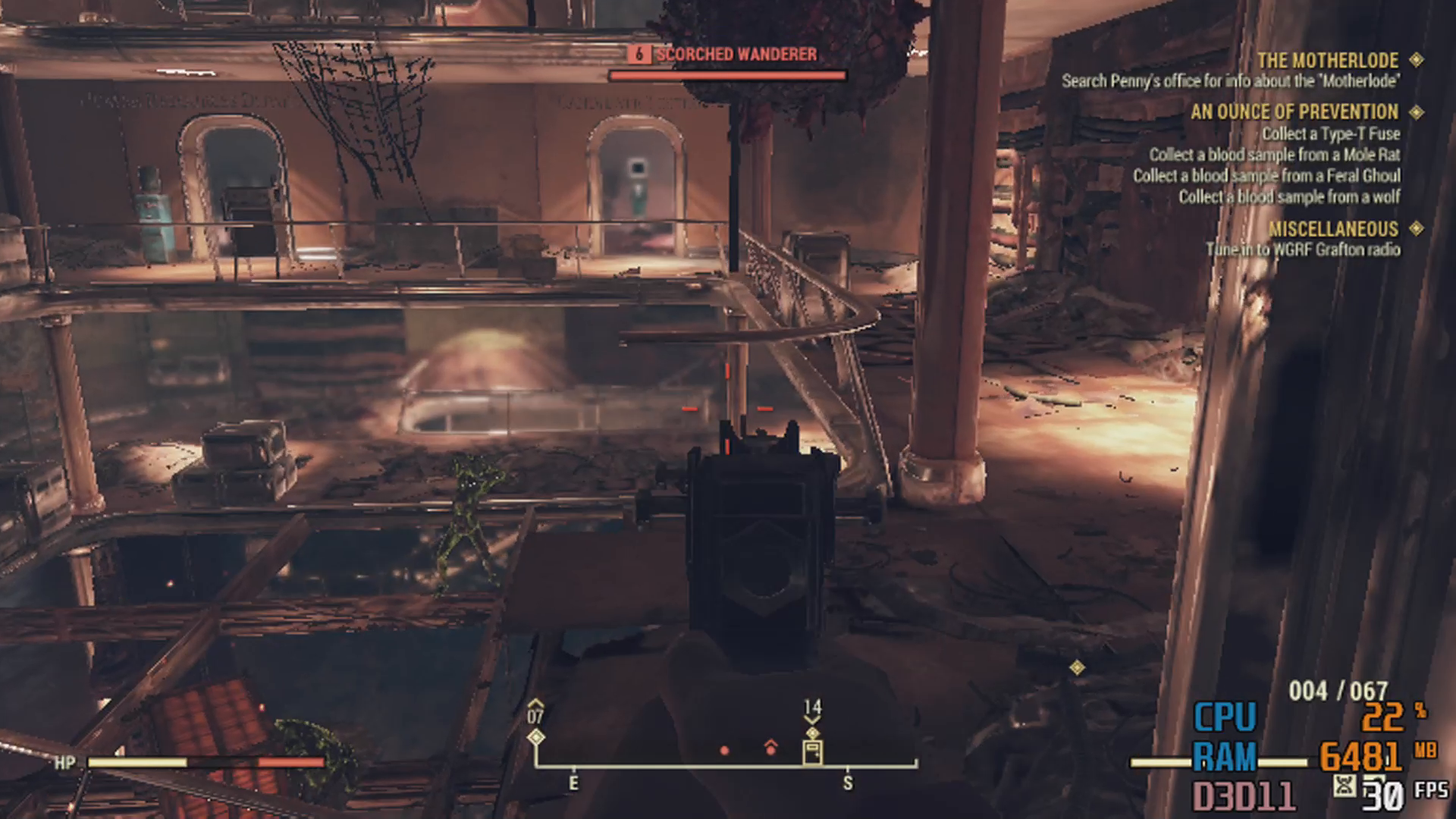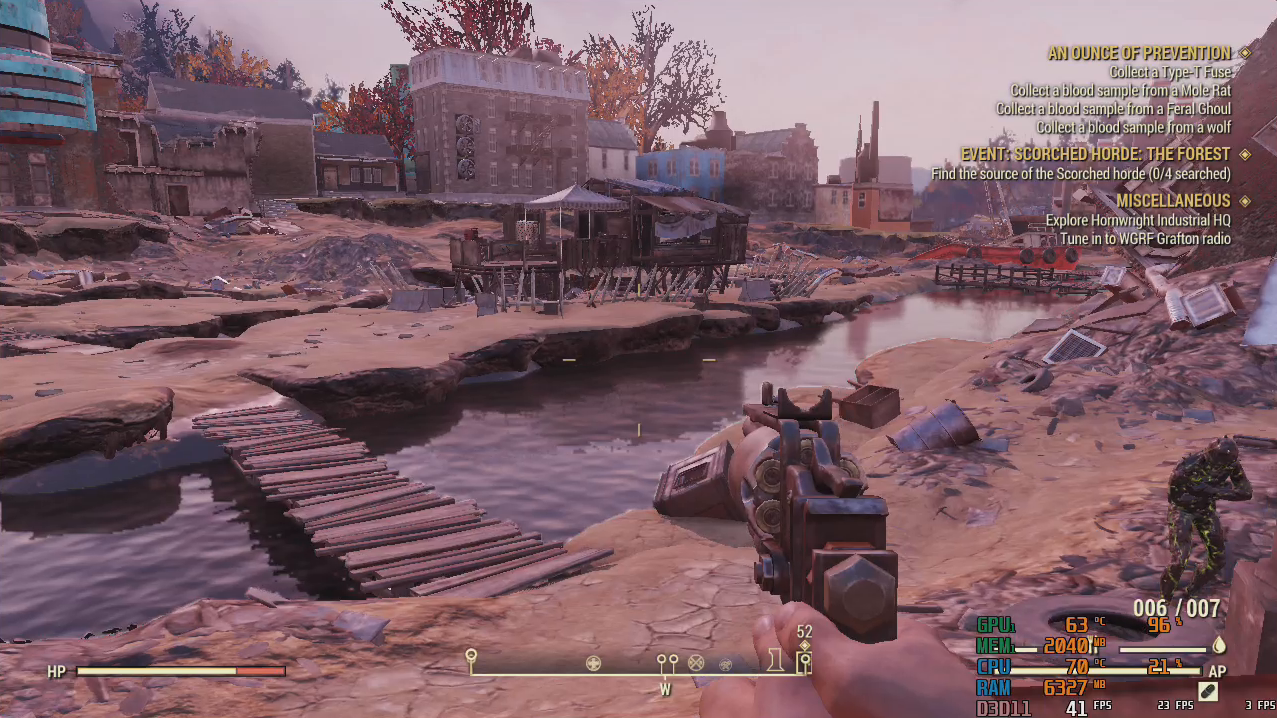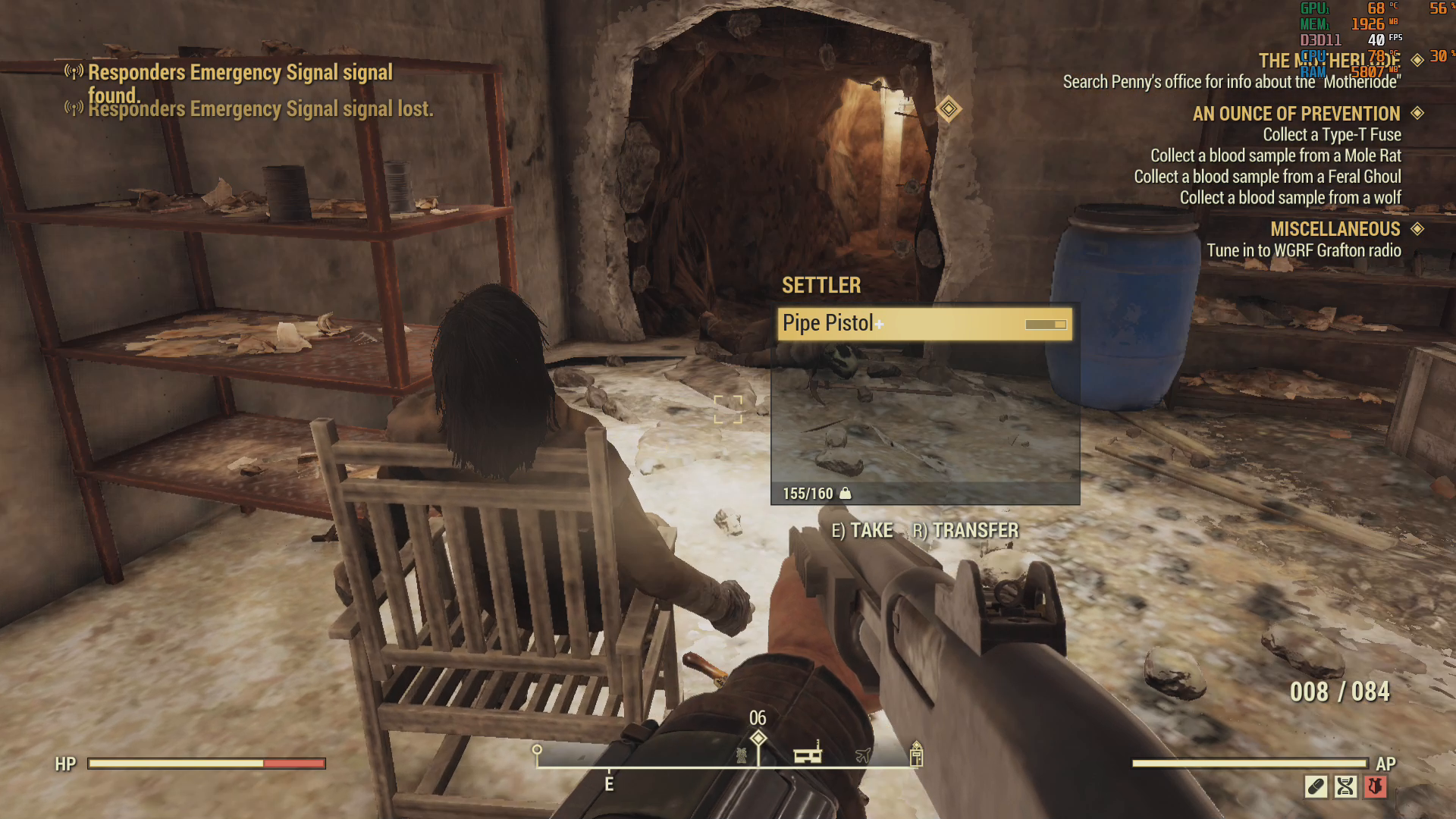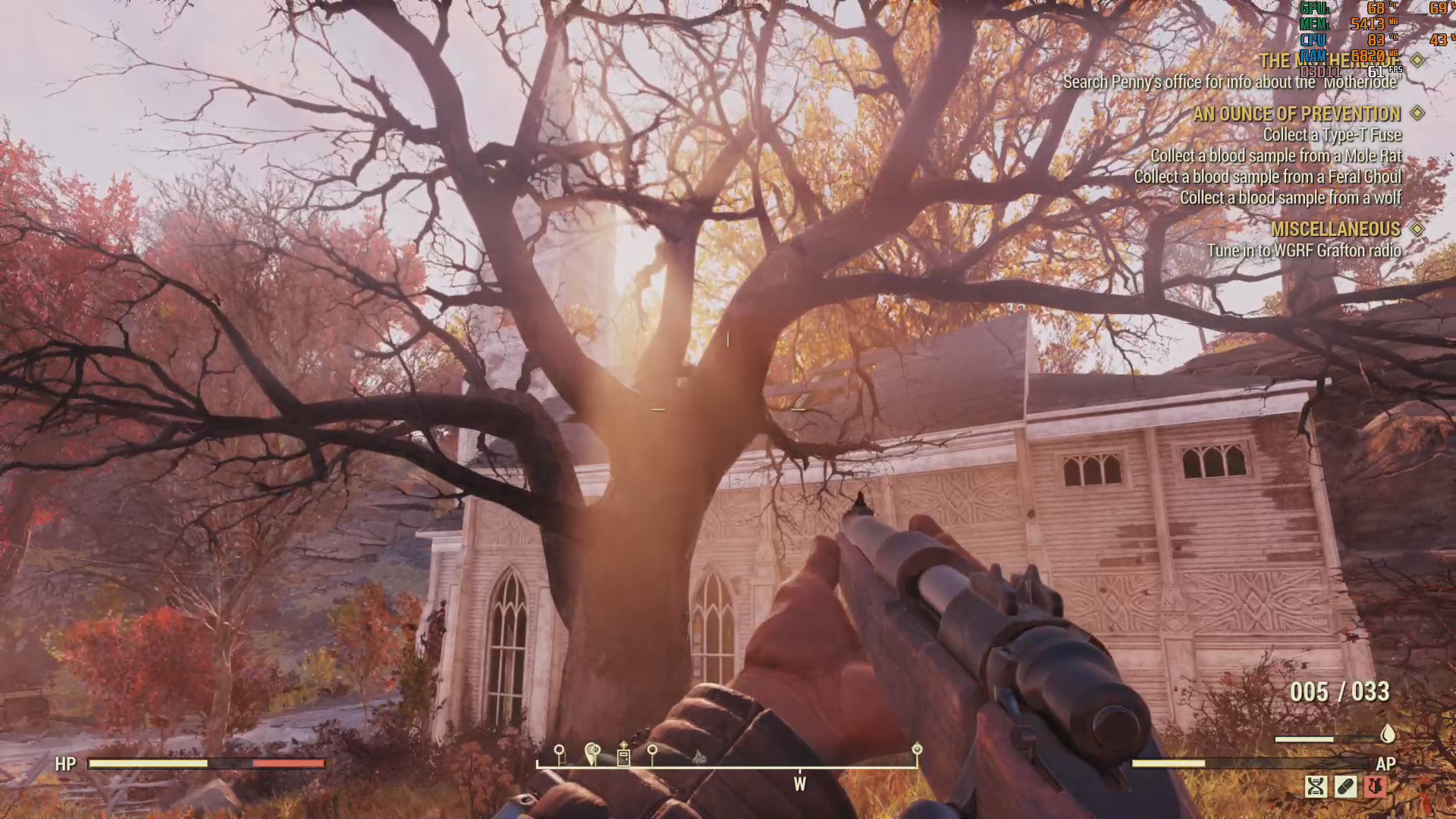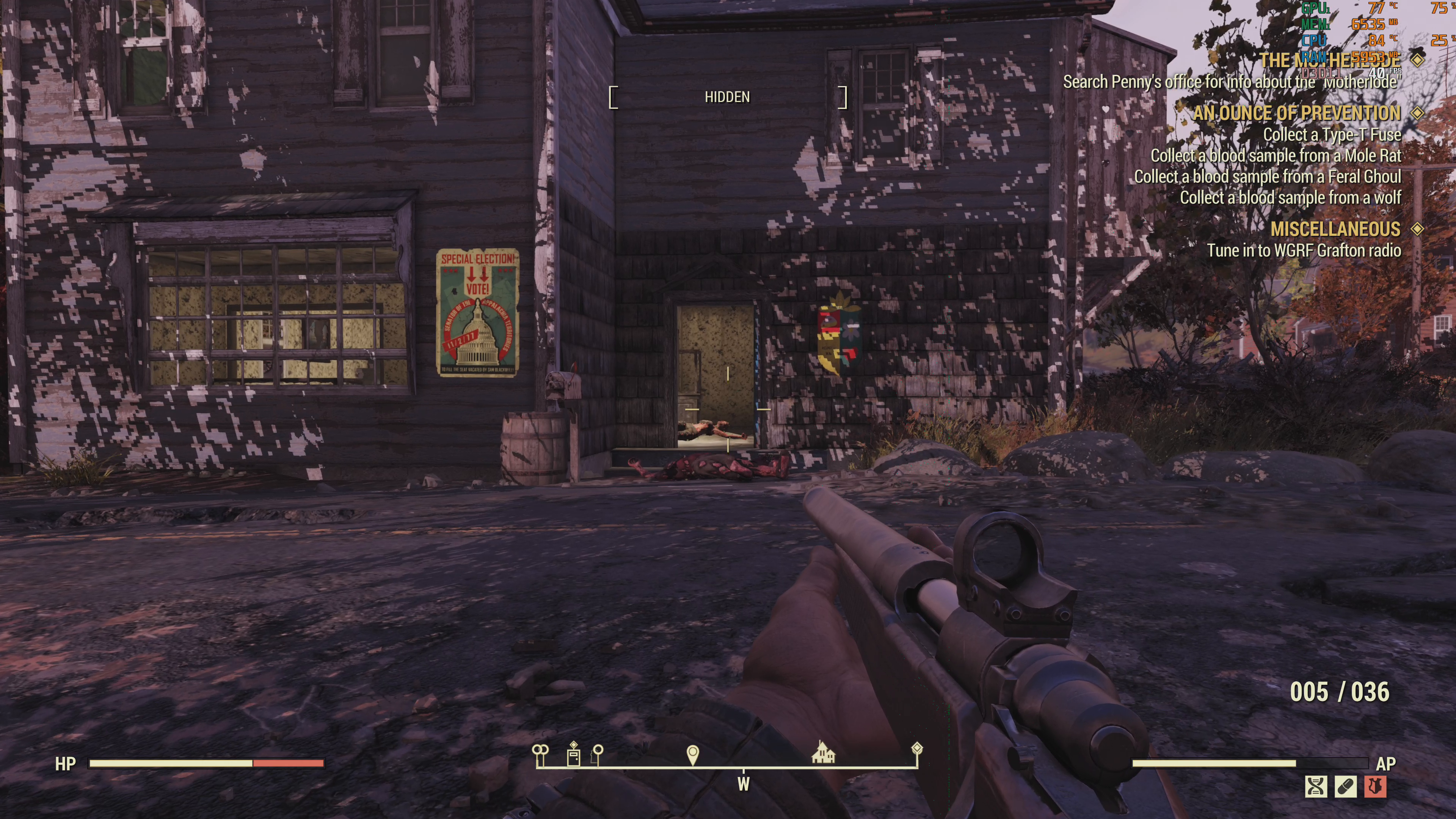Fallout 76 on a $55 AMD Athlon? How it Plays on GPUs Up to GTX 1070
Bethesda' Softwork's post-apocalyptic franchise took an unexpected turn with the release of Fallout 76, the first multiplayer Fallout game. Originally conceptualized as the multiplayer component of Fallout 4, Bethesda Softworks decided to spin it off as its own separate game set in West Virginia. Fallout 4 runs in Bethesda's own Creation Engine, the same Graphical Engine powering the legendary Elder Scrolls V: Skyrim, which is in turn based on the Gamebryo Engine that powers everything from Fallout 3 to Morrowind and Oblivion.
But how does Fallout 76 actually perform? What sort of experience can you expect at different levels of hardware? To find out, we tested on six different PCs with GPUs ranging from Intel HD 620 integrated graphics to an Nvidia GTX 1070.
There was a jump in minimum requirements from Fallout 4 to Fallout 76.
| Row 0 - Cell 0 | Fallout 4 Minimum Requirements | Fallout 76 Minimum Requirements |
| CPU | Intel Core i5-2300 2.8 GHzAMD Phenom II X4 945 3.0 GHz | Intel Core i5-6600K 3.5 GHzAMD Ryzen 3 1300X 3.5 GHz |
| GPU | NVIDIA GeForce GTX 550 Ti 2GBAMD Radeon HD 7870 2GB | NVIDIA GeForce GTX 780 3GBAMD Radeon R9 285 2GB |
| RAM | 8GB | 8GB |
But our results show that, with the right tweaks, you can play Fallout 76 even on integrated graphics, but if you want the best possible experience at 4K resolution, even the GTX 1070 card isn't strong enough.
| GPU | Best Resolution | Settings | Frames per second (fps) |
| Intel HD 620 (Dell XPS 13) | 768x432 | Custom ultra low | 30 |
| AMD Athlon 200GE | 960x540 | Custom ultra low | 40 |
| Nvidia GeForce MX150 (Xiaomi Pro) | 1280x720 | Low | 40 |
| Nvidia GTX 1050 Ti (MSI GL62M-7REX) | 1280x720 | Medium/High | 60 |
| Nvidia GTX 1060 (Alienware 15 R3) | 1920x1080 | High | 60 |
| Nvidia GTX 1070 (Alienware 15 R3) | 1920x1080 | Ultra | 60 |
The Intel HD experience
Given the minimum requirements, I had very little hope that the game could be played at all on a Dell XPS 13 9360 from 2017. While the Intel Core i7-8550U and 8GB of RAM should be enough, the Intel UHD Graphics 620 leaves a lot to be desired.
And yet...with a little bit of effort, the game can be made to work better than you would expect. There is a fair bit you can do after dropping all the settings to the lowest.
Since we are working with the Creation Engine, the configuration files for Fallout 76 are easily reachable in the Document Folder under My Games/Fallout 76. The Fallout76Prefs.ini has a couple of useful variables to tweak.
Get Tom's Hardware's best news and in-depth reviews, straight to your inbox.
For example, while you can't remove shadows entirely, you can limit them to a small area around the camera with:
fShadowDistance=0.0000
fDirShadowDistance=0.0000
iDirShadowSplits=1
You can also reduce grass draw distance to an absolute minimum, limiting grass and its effect to a very small area around the camera with:
fGrassStartFadeDistance=0.0000
fGrassMaxStartFadeDistance=0.0000
fGrassMinStartFadeDistance=0.0000
AntiAliasing is always enabled in Fallout 76, but you can force-disable it by setting:
sAntiAliasing=0
You can tweak the general draw distances a bit for extra performance, limiting the draw distance of non-essential objects and lowering the draw distance of enemies and other players a bit more but not enough to make it impossible to play.
fLODFadeOutMultActors=4.0000
fLODFadeOutMultItems=1.0000
fLODFadeOutMultObjects=2.0000
fLODFadeOutMultSkyCell=1.0000
Finally, you can customize the full screen resolution of the game to almost any 16:9 resolution by first adding the custom resolution in the control panel of the GPU (Intel for our case) and then changing a couple of lines in the file.
iSize H=432
iSize W=768
While playing in 768x432 sounds like a torturing experience, the gameplay loops and different elements of Fallout 76 continued being perfectly readable, and the basic gameplay loop worked even better than I expected while maintaining a solid average of 30 fps.
As you can imagine the game does not look particularly good at this state, but it works!
Low-End Integrated AMD Vega Graphics
With the introduction of Ryzen APUs, AMD started packing their Vega GPU architecture on integrated GPUs which resulted in an amazing performance on some rather affordable packages.
The cheapest of the Ryzen APUs is the AMD Ryzen 3 2200G at about $100. But recently AMD released the Athlon 200GE: a dual-core GPU with three Vega compute units for only $55. I have been experimenting extensively with this APU, and paired with dual channel 2666MHz RAM (the highest RAM clock speed supported) it was able to play anything I threw at it in one form or another.
So coming into Fallout 76, I at least expected to be able to use the same low graphical tweaks to get the game running at 720p resolution.
Initially, the game was maintaining almost 30 fps under those conditions, but I quickly ran into areas where the game would crash every time the area loaded, something that stopped happening on a lower resolution. This might be a bug in the current version of the game (as the current version has gained a bit of a reputation for being unstable), but dropping it to 960x540 quickly put an end to that while maintaining an excellent performance average of over 40-50 fps.
Compared to our previous experiment, the jump to 960x540 is noticeable. The game is still on its forced lowest, so all previous comments apply.
Let's finally take the leap to a dedicated GPU.
Nvidia GeForce GT 1030
My daily driver is a Xiaomi Mi Notebook Pro laptop from 2017 sporting an Intel Core i5-8250U quad-core CPU, 8GB of RAM and an Nvidia GeForce MX150 GPU. The MX150 is the mobile version of the Nvidia GeForce GT 1030, which is based off the Pascal architecture and, therefore, is not ideal for heavy gaming in most cases.
However, the MX150 is perfectly appropriate for Fallout 76 on the lowest settings with the adjustments to Shadows and AntiAliasing mentioned above, while maintaining a 45 fps average.
I did not quite notice the increase in object draw distance as I expected, and while the jump to 720p is very appreciated, we are still essentially dealing with the lowest settings: no anti-aliasing and shadows under a very low draw distance. The basic gameplay loop works and feels great in motion!
GTX 1050 Ti
Jumping into the MSI GL62M-7REX with a Core i7-7700HQ CPU, 8GB of DDR4 RAM and an Nvidia GeForce GTX 1050 Ti GPU with 4GB of VRAM, the result was unexpected.
On 720p, the laptop played on high settings pretty fantastically with 60 fps...for the most part. While the creation Engine continually shows its age in details like animations (or interiors), but some of the new details of this iteration help a fair bit on the lush outside environment. Well, as much as you can appreciate them on 720p.
There has been discussion among gamers on the odd performance this game can have in certain areas on consoles and some other specific hardware. I noticed some of this myself on this laptop, with certain buildings or areas dropping all the way to 30-40 fps for absolutely no reason, even on 720p. With the GPU usage hovering around 50 percent, these unexpected heavy areas did not appear frequently during my tests but were definitely consistent, even after recent performance patches.
Something similar happened all through the game when running at 1080p resolution. Even on the lowest resolution, the game would get stuck around 40 fps at any and all areas tested, with a GPU usage of no more than 70 percent.
I experimented a bit, but I was not able to zero in on exactly what the bottleneck is for this case.
Let's jump up a level.
GTX 1060
The Alienware 15 R3, packed with a Core i7-7700HQ CPU, 8GB of RAM and an Nvidia GeForce GTX 1060 GPU offered great performance on Fallout 76 in our tests.
This laptop is easily capable of reaching high settings and maintaining a 60 fps cap with space to spare. However, it cannot handle full maxed out settings without experiencing frequent drops.
There are plenty of neat illumination effects and other bells and whistles that help the environments pop.
Nvidia GeForce GTX 1070
The Alienware 15 R3, with a Core i7-7820HQ, 16GB of RAM and an Nvidia GeForce GTX 1070 GPU can easily max out the settings on 1080p with what initially seems like computing power to spare.
A recent update has removed the 60 fps cap and fixed the speed issues that this would cause, but testing with this laptop did not quite provide the expected results. Performance fluctuated between 60 and 90 fps without full GPU utilization. Even while using dynamic VSYNC, things ran far from the stable 80, 90 or 120 fps that a lot of people would like.
Graphically, exteriors looks gorgeous on the GTX 1070 card, while the animations and interiors could leave some high-graphics aficionados a bit unsatisfied.
If you prefer a higher resolution over higher frame rates, this laptop can do 4K...as long as you set the lowest possible settings and limit your expectations to 40 fps.
You cannot beat the clarity of full 4K, but the reduction in settings (which dampens a lot of the awe of the game's external environments) and sub 60 fps might all be too much for some people to handle.
Conclusion
Fallout 76 is an experiment on multiplayer using a slightly improved older engine with modern minimum requirements that might be a tad exaggerated. Thanks to a very flexible configuration file, it can run in low resolution in modern Intel HD GPUs, as well as AMD's integrated Vega GPUs. The game's gameplay loop actually works pretty well in low resolutions, so you can easily get away with playing this way if you must.
A low-end dedicated GPU, like an MX150 or GT 1030 can almost run the game in 720p on the lowest settings, and with some small configuration, file tweaks can achieve 30-40 fps averages. It will not look pretty, but it will work well.
Jumping to a laptop with a really decent Core i7 and 1050 Ti means that we are easily able to play on medium settings on 720p and 60 fps, with some drops on some specific parts of the map. On 1080p some of the game's weirder performance issues come to light, as fps fluctuates between 30-40 fps on all areas on the lowest settings even while the GPU seems to be sub-utilized.
Finally, with an Alienware 15 R3 with a GTX 1060, you can go for high settings on 1080 while expecting a mostly 60 fps average. The game's exteriors and illumination look pretty amazing, although the interiors and animations can be a tad dated.
Jumping to a GTX 1070, the game can easily max settings on 1080p while maintaining the 60 fps average. Newer updates make it possible to unlock the 60 fps frame rate, but sadly it was not possible to reach a stable 80 or 90 fps at this level. If the priority is resolution, 4K is feasible on lower settings at 40 FPS.
